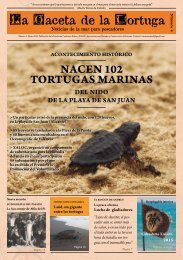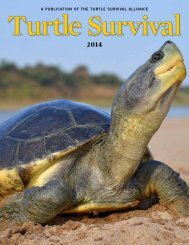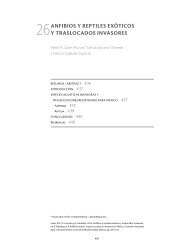tsrp63entire
tsrp63entire
tsrp63entire
Create successful ePaper yourself
Turn your PDF publications into a flip-book with our unique Google optimized e-Paper software.
established as part of this project (Haigh et al. 2007) and has also been established at two new<br />
sites on the Coromandel Peninsula. The control of mammalian predators also occurs in<br />
Archey’s frog habitat in the Coromandel Ranges, as part of other species or ecosystem<br />
restoration programmes.<br />
Disease surveillance (since 2005), strict disease hygiene protocols and the establishment of a<br />
new wild population of chytrid-free frogs at Pureora Forest have been undertaken to mitigate<br />
the disease threat to this species. Archey’s frogs were taken into captivity at the University of<br />
Canterbury between 2000 and 2006 (Shaw & Holzapfel 2008), and transferred to Auckland Zoo in<br />
2005 and 2006 to develop captive husbandry techniques, establish captive breeding and form the<br />
nucleus of an ex situ insurance population. All current captive populations of Archey’s frog are<br />
now free of amphibian chytrid fungus.<br />
Hochstetter’s frog<br />
Past and current management of this species primarily consists of habitat protection and<br />
statutory advocacy. Recent surveys have extended the known range of Hochstetter’s frog and<br />
genetic research has identified significant genetic variation within this species, challenging the<br />
management of this species as a single ESU.<br />
Low-intensity monitoring of Hochstetter’s frogs has occurred in a few populations in the past;<br />
however, a variety of techniques was used, limiting the potential for comparative analyses.<br />
Therefore, a new robust technique—site occupancy modelling (McKenzie et al. 2002)—is<br />
now planned to be established in Hochstetter’s frog populations at Great Barrier Island<br />
(Aotea Island), Waitakere Ranges, Hunua Ranges and Otawa. A 2006 study using this technique<br />
in the Hunua Ranges indicated that Hochstetter’s frogs may benefit from mammalian pest<br />
control for ecosystem management (M. Crossland & T. Wilson, Department of Conservation,<br />
unpubl. data).<br />
Predator control programmes targeting other species or ecosystem outcomes have occurred<br />
or are continuing in portions of the Raukumara, Whareorino, North Pureora, Coromandel,<br />
Waitakere, Hunua and Warkworth populations; and the population discovered at Maungatautari<br />
in 2004 has been enclosed by a predator-exclusion fence.<br />
Hochstetter’s frogs were taken into captivity at the University of Canterbury between 2000 and<br />
2004 (Shaw & Holzapfel 2008), and moved to an outdoor captive breeding facility at<br />
Hamilton Zoo in 2006 to develop captive husbandry techniques and maintain a potential<br />
ex situ insurance population.<br />
An amphibian chytrid fungus survey that included populations from Northland through to<br />
North Pureora Forest Park was completed in 2008. All frogs tested negative for amphibian<br />
chytrid fungus (Thurley & Haigh 2008).<br />
Maud Island frog<br />
Early management actions extended the range of this species on Maud Island by translocating<br />
frogs from a 16-ha forest remnant to a second location on the island (Bell et al. 2004b) and<br />
facilitating habitat restoration. Population monitoring since 1976 indicates a fluctuating<br />
population at two monitoring plots in the forest remnant and a steady increase in the rate of<br />
recruitment in the translocated population on the island (Newman 1990; Bell et al. 2004b;<br />
Pledger & Bell 2008, 2009).<br />
In 1997, frogs were translocated to predator-free Motuara Island and rigorous monitoring<br />
continued until 2003, when results indicated that the population was self-sustaining (Tocher &<br />
Pledger 2005). As part of a study to assess post-release dispersal, a third wild population of<br />
100 frogs was translocated from Maud Island to Long Island (also rodent free) in 2006. However,<br />
intensive post-release monitoring indicated that this translocation was unsuccessful, potentially<br />
as a result of little spotted kiwi (Apteryx owenii) predation—although the exact causes of the<br />
failure remain unknown (Germano et al. unpubl. data 2010).<br />
8 Bishop et al.—Native frog recovery plan, 2013–2018





